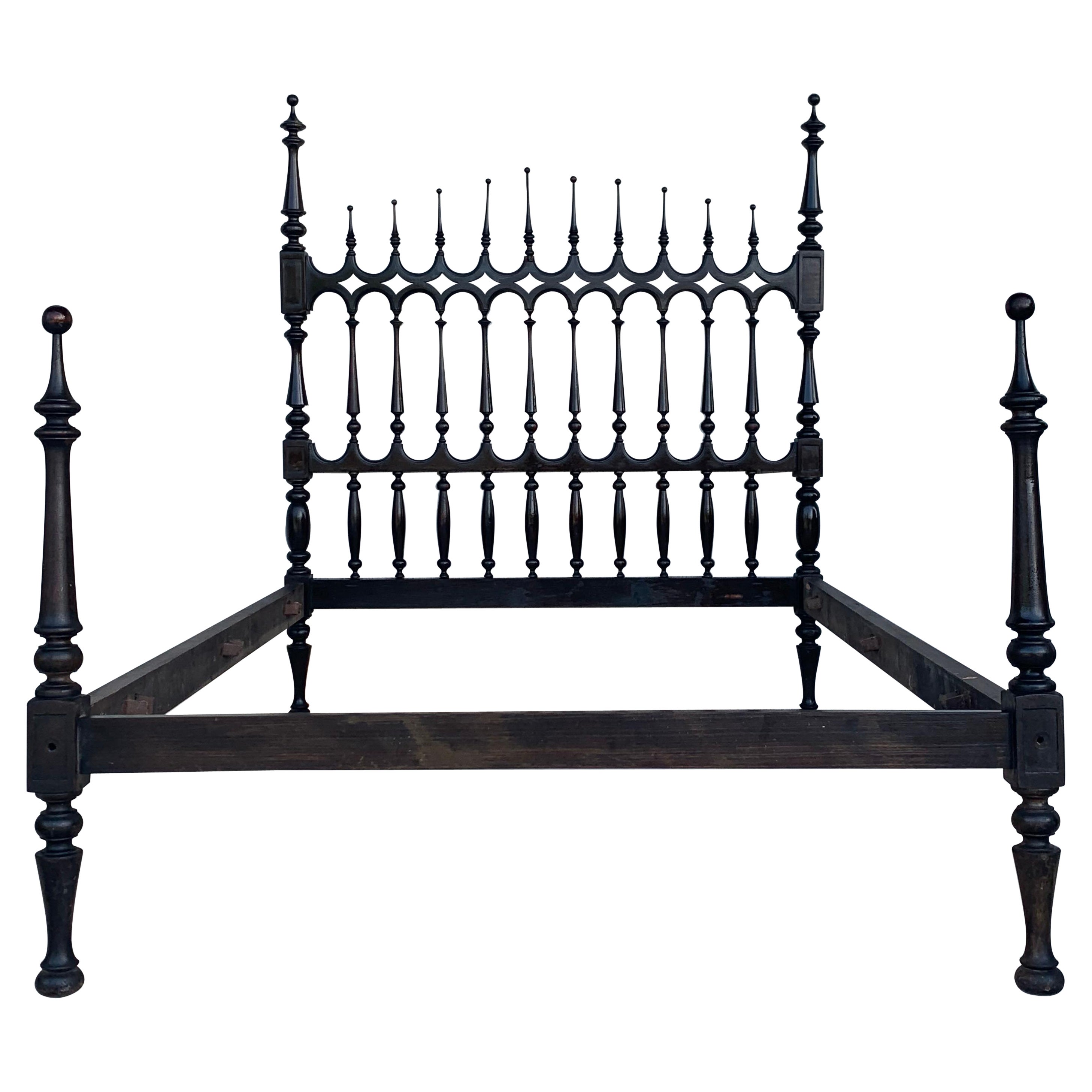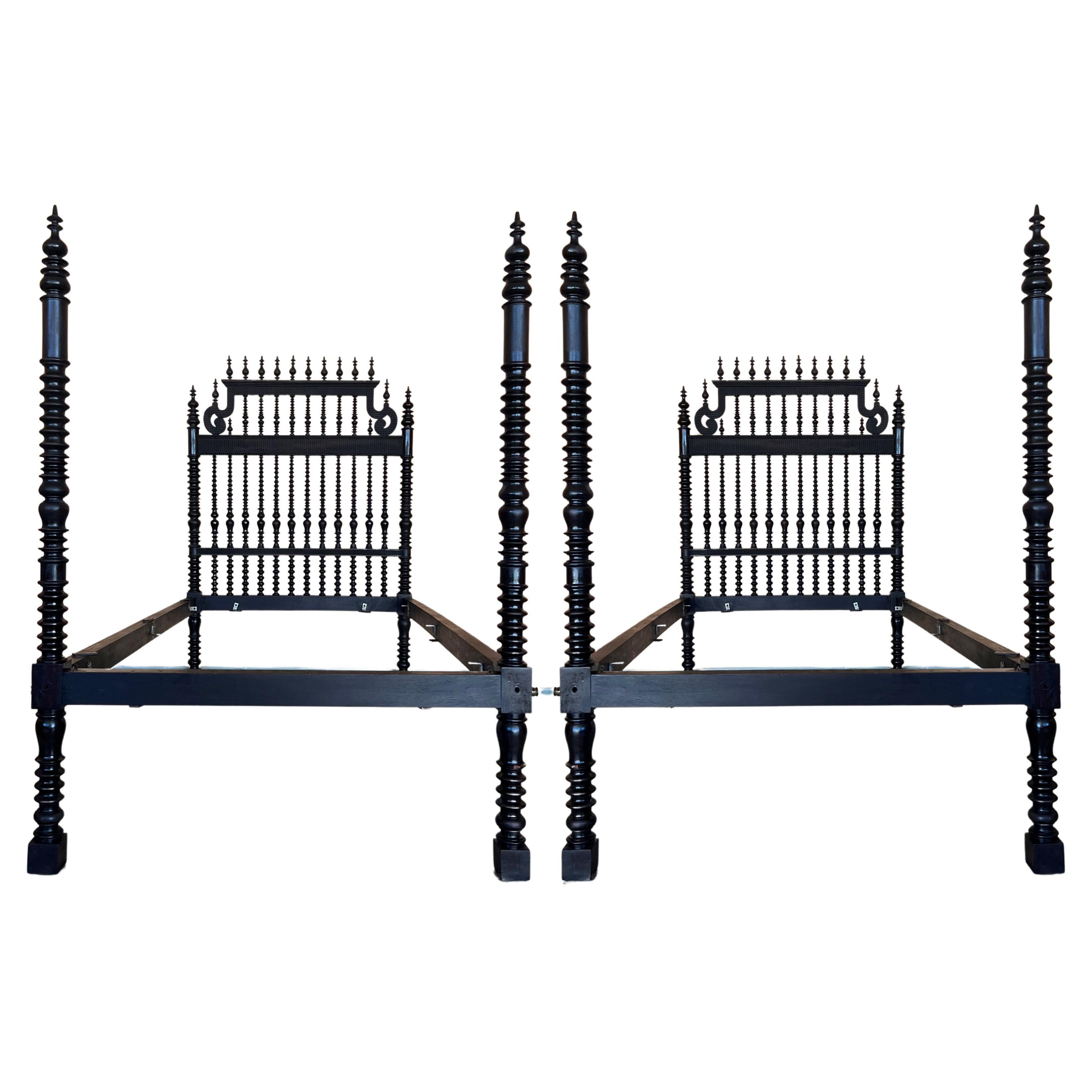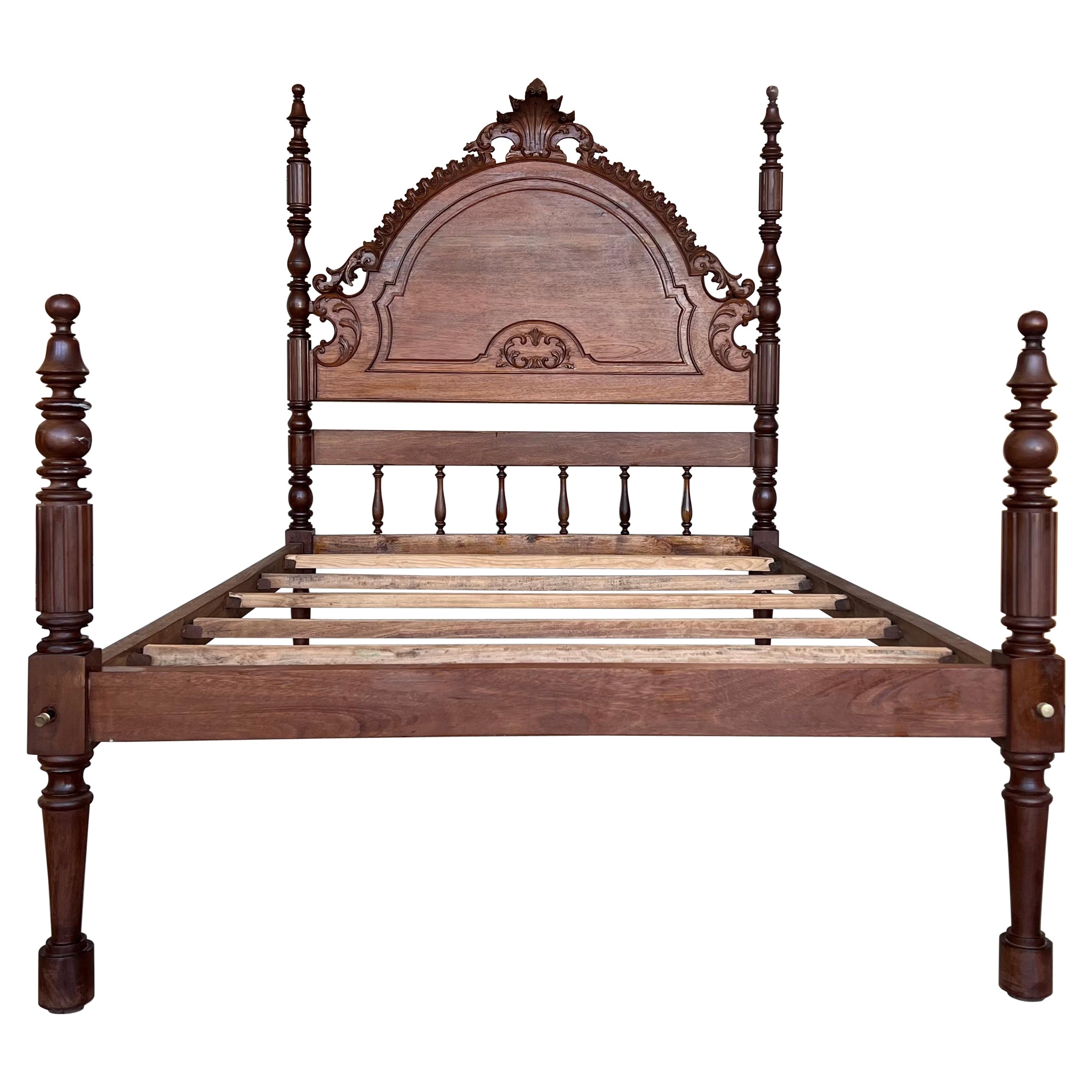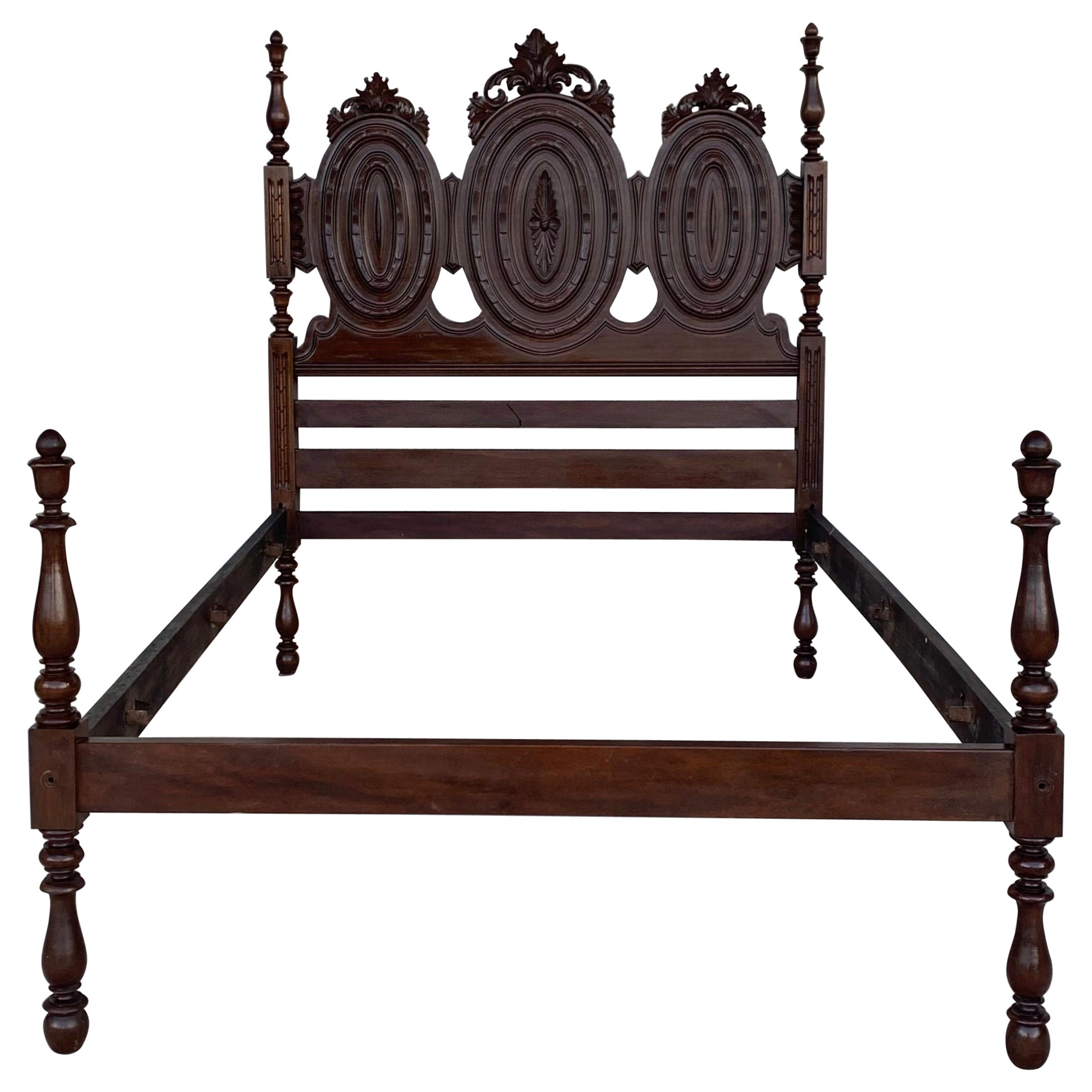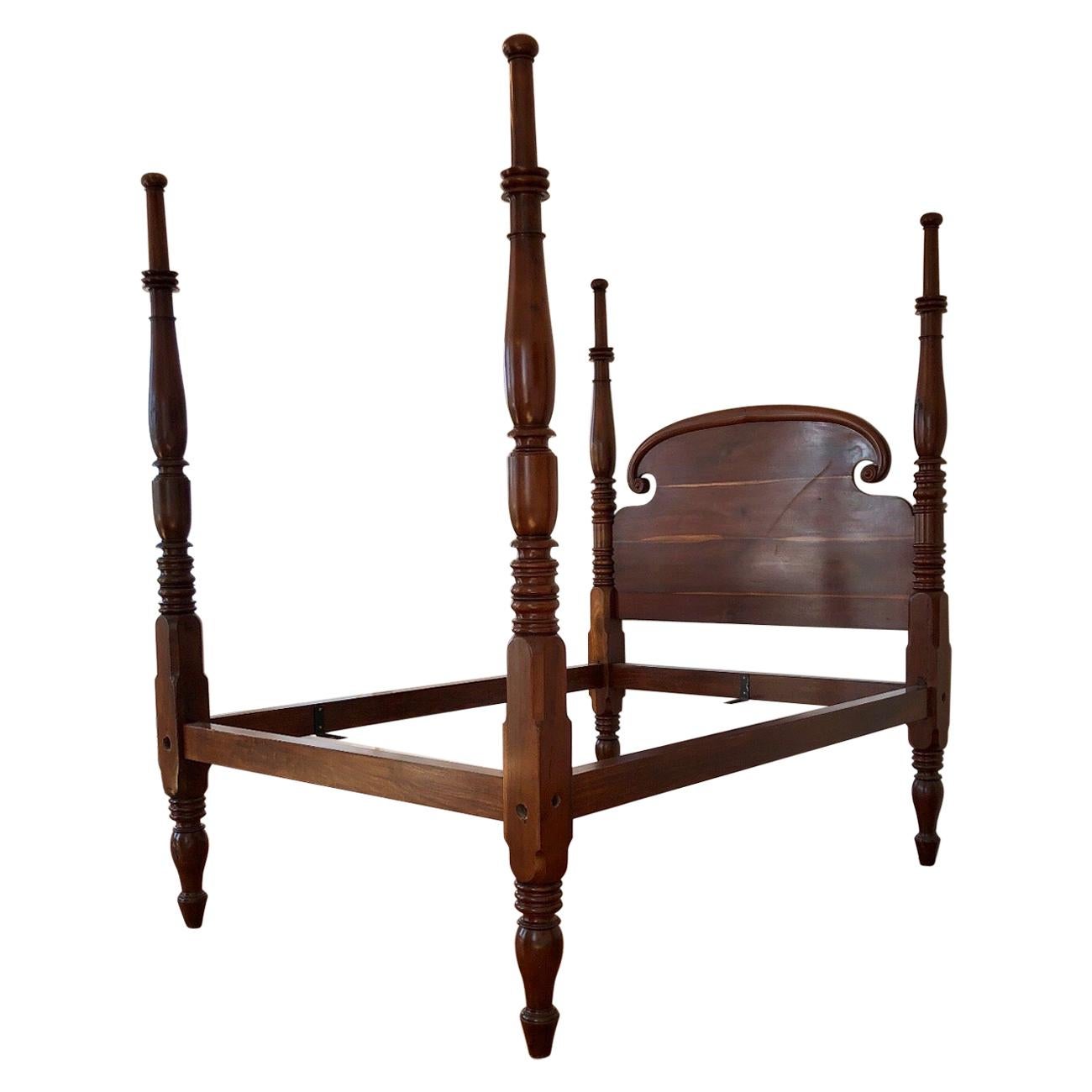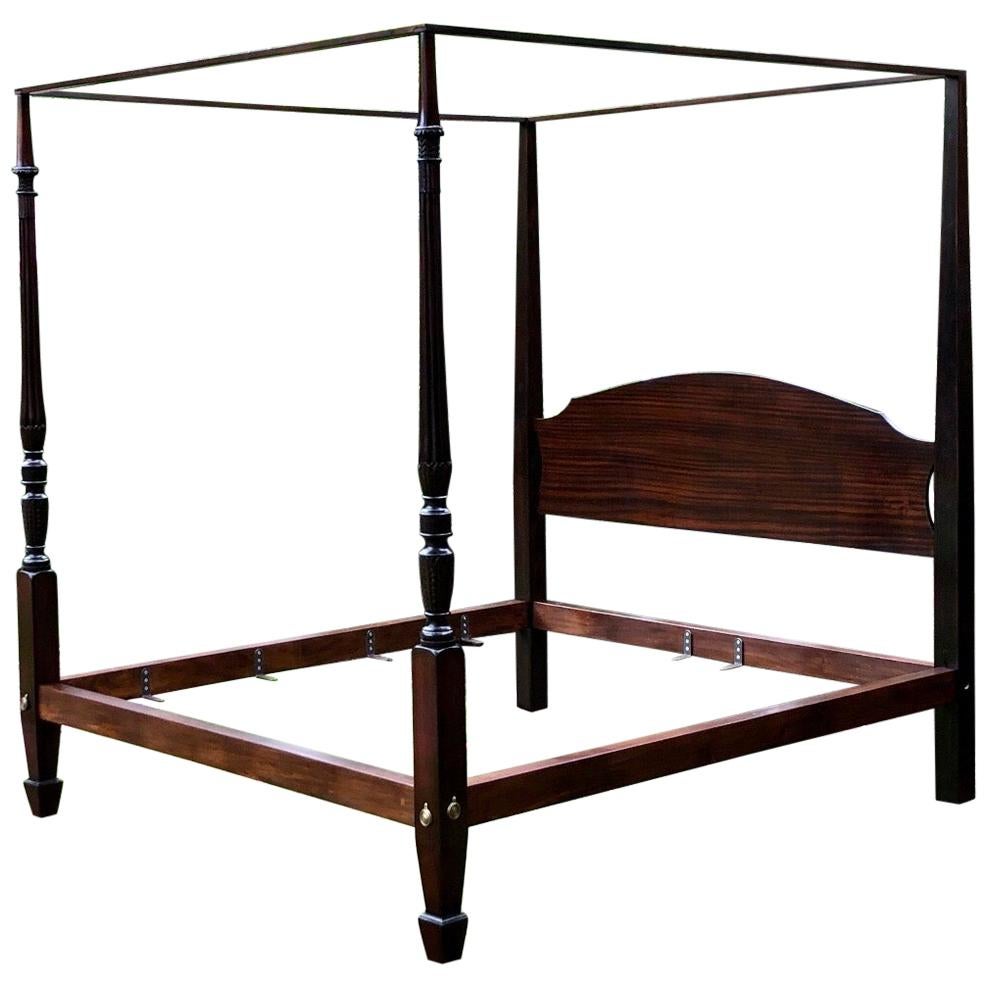Items Similar to 19th Century, Baroque Full Bed, Original Four Fluted Poster Spanish Bed
Want more images or videos?
Request additional images or videos from the seller
1 of 15
19th Century, Baroque Full Bed, Original Four Fluted Poster Spanish Bed
About the Item
19th Century baroque bed, original Spanish bed.
This queen size 4-poster bed is hand carved with elaborate details, fluted turned post, 3D open spiral twist spindles, and moorish details represented by the repetition of arches. It is carved and turned from solid alder wood which is known for its natural distressing and characteristics. This bed is a current representation of Indo-Portuguese furniture. An era long passed and almost lost. Indo-Portuguese beginnings Moorish architecture is a variation of Islamic architecture. It developed as a group of individuals of Islamic faith spread from the middle east to the Maghreb, an area which included parts of North Africa and Spain. Their architecture was noted for its unique characteristics, a result of the intertwined influences of culture and religion. Some of the most prominent examples of Moorish architecture can be found in Spain with most built between the beginning of the 12th century and the end of the 16th century. With this new cultural influence there came an advancement of ornamental art especially in Northern India. Resulting in carved furniture influenced by the styles and fashion from Arab states, Turkey and Persia. Cabinet and furniture making had a turning point during this period. Introducing elaborately carved wood and chest with inlay work, brass corners, metal rosette and knobs. The concept of more useful furniture such as the dressing table was discovered in Indian during this period. The Portuguese where the masters of navigation and conquest and started settlements on the western coast of India. One being Goa in 1510 and in 1530 it became the capital of the Portuguese Eastern Empire. It was in Goa that the Portuguese were introduced to the blacksmiths and the art of carpentry, carving, and joinery. Likewise the Indians crossed to Lisbon and learned the techniques of the Portuguese and that was the beginning of Indo-Portuguese furniture. By the end of the 17th century the Goans had Indian influences meshed with the Western Era architecture. The locals had a desire for artistic furniture. Tables, benches, chairs, rocking chairs, easy chairs, stools, sofas, beds, day beds, cupboards, cabinet and chest came to be in favour as known today as Indo-Portuguese furniture. As trade heightened this type of furniture spread throughout Europe. When the 20th century came many where drawn to more simple lines and this style fell out of favour and many of the craftsmen that had passed along these techniques generation to generation where no more. Today there are a few artisans who are practicing this craft. This bed is a current representation of an era and craftsman long passed.This Queen size 4-poster bed is hand carved with elaborate details, spiral turned post, 3D open spiral twist spindles, and Moorish details represented by the repetition of arches. It is carved and turned from solid alder wood which is known for its natural distressing and characteristics. This bed is a current representation of Indo-Portuguese furniture. An era long passed and almost lost. Indo-Portuguese beginnings Moorish architecture is a variation of Islamic architecture. It developed as a group of individuals of Islamic faith spread from the Middle East to the Maghreb, an area which included parts of North Africa and Spain. Their architecture was noted for its unique characteristics, a result of the intertwined influences of culture and religion. Some of the most prominent examples of Moorish architecture can be found in Spain with most built between the beginning of the 12th century and the end of the 16th century. With this new cultural influence there came an advancement of ornamental art especially in Northern India. Resulting in carved furniture influenced by the styles and fashion from Arab states, Turkey and Persia. Cabinet and furniture making had a turning point during this period. Introducing elaborately carved wood and chest with inlay work, brass corners, metal rosette and knobs. The concept of more useful furniture such as the dressing table was discovered in Indian during this period. The Portuguese where the masters of navigation and conquest and started settlements on the Western coast of India. One being Goa in 1510 and in 1530 it became the capital of the Portuguese Eastern Empire. It was in Goa that the Portuguese were introduced to the blacksmiths and the art of carpentry, carving, and joinery. Likewise the Indians crossed to Lisbon and learned the techniques of the Portuguese and that was the beginning of Indo-Portuguese furniture. By the end of the 17th century the Goans had Indian influences meshed with the Western Era architecture. The locals had a desire for artistic furniture. Tables, benches, chairs, rocking chairs, easy chairs, stools, sofas, beds, day beds, cupboards, cabinet and chest came to be in favour as known today as Indo-Portuguese furniture. As trade heightened this type of furniture spread throughout Europe. When the 20th century came many where drawn to more simple lines and this style fell out of favour and many of the craftsmen that had passed along these techniques generation to generation where no more. Today there are a few artisans who are practicing this craft. This bed is a current representation of an era and craftsman long passed.
- Dimensions:Height: 66.15 in (168 cm)Width: 54.73 in (139 cm)Depth: 78.75 in (200 cm)
- Style:Baroque (In the Style Of)
- Materials and Techniques:
- Place of Origin:
- Period:
- Date of Manufacture:circa 1880
- Condition:Refinished. Wear consistent with age and use.
- Seller Location:Miami, FL
- Reference Number:1stDibs: LU1726232659112
About the Seller
4.7
Platinum Seller
These expertly vetted sellers are 1stDibs' most experienced sellers and are rated highest by our customers.
Established in 1995
1stDibs seller since 2015
1,054 sales on 1stDibs
Typical response time: <1 hour
- ShippingRetrieving quote...Ships From: Miami, FL
- Return PolicyA return for this item may be initiated within 3 days of delivery.
More From This SellerView All
- 19th Century Baroque Full Bed, Original Four Poster Lisbon BedLocated in Miami, FL19th century Baroque bed, original Lisbon bed The measurements you can see in the listing is only for the shipping, the This Queen size 4-poster bed is h...Category
Antique Late 19th Century Portuguese Baroque Beds and Bed Frames
MaterialsWalnut
- Pair of 19th Century Baroque Full Bed, Original Four Poster Lisbon BedLocated in Miami, FL19th century Baroque bed, original Lisbon bed The measurements you can see in the listing is only for the shipping, the This Full size 4-poster bed is hand carved with elaborate d...Category
Antique Late 19th Century Portuguese Baroque Beds and Bed Frames
MaterialsWalnut
- 20th Century Full Bed, Original Four Fluted Poster Spanish Bed with Wood SlabsLocated in Miami, FL20th century baroque bed, original Spanish bed. This queen-size 4-poster bed is hand carved with elaborate details, fluted turned post, 3D open spiral twist spindles, and Moorish ...Category
Early 20th Century Spanish Baroque Beds and Bed Frames
MaterialsWalnut
- Early 20th Carved Medallions Full Bed, Original Four Poster Lisbon BedLocated in Miami, FL19th century Baroque bed, original Lisbon bed This Queen size 4-poster bed is hand carved with elaborate details, spiral turned post, 3D open spiral twist ...Category
Early 20th Century Portuguese Baroque Beds and Bed Frames
MaterialsWalnut
- 18th Century Medallion Baroque Queen Bed, Original Lisbon BedLocated in Miami, FL18th century Baroque bed, original Lisbon bed A Portuguese bed of carved and turned walnut with 17th century elements, the headboard profusely mounted with spiral-twist spindles and ...Category
Antique Late 18th Century Portuguese Baroque Beds and Bed Frames
MaterialsWalnut
- Large Black and Golden Iron & Bronze Full Bed, Early 19th CenturyLocated in Miami, FLLarge black and golden iron & bronze full bed, early 19th century This original bed has the slabs fixed and you can fold the bed as you can see in the pictures. Its very easy to use...Category
Antique Late 19th Century French Baroque Beds and Bed Frames
MaterialsBronze, Iron
You May Also Like
- St. Croix Regency Four Poster Mahogany Queen Bed, 19th CenturyLocated in Charleston, SCThis elegant West Indies poster bed was made in the Caribbean Island of Saint Croix. The Headboard is solid mahogany and carved in the Rams Horn style. The four post are solid mahogany and hand turned. The simplicity of the turnings and classic Rams Horn headboard makes this Dutch Colonial Bed...Category
Antique 19th Century Virgin Islands Dutch Colonial Beds and Bed Frames
MaterialsMahogany
- Late 19th Century King Size American Mahogany Four Poster BedLocated in Charleston, SCThis wonderful New York Four Poster bed has a simple poplar headboard and tester for draping. The mahogany foot post have a block spade foot below the bed bolts. The post continue up...Category
Antique 19th Century American Federal Beds and Bed Frames
MaterialsMahogany, Poplar
- Early 19th Century Charleston Mahogany Four-Poster Bed with TesterLocated in Charleston, SCThis classical four-poster bed was made in Charleston, South Carolina, in the first quarter of the 19th century. This piece features carving on the foot posts in the form of reeded palm columns...Category
Antique Early 19th Century American American Classical Beds and Bed Frames
MaterialsMahogany
- American Federal Four Poster Mahogany King-Size Bed, Early 19th CenturyLocated in Charleston, SCThis elegant New York poster bed has some of the finest hand carving and delicate details making it a very fine example of a Federal bed. The solid mah...Category
Antique Early 19th Century American Federal Beds and Bed Frames
MaterialsPoplar, Mahogany
- Bed, 19th Century, Italian, Baroque, Carved, Painted, Gilded, Armorial CartoucheLocated in BUNGAY, SUFFOLKThe headboard is surmounted with a carved cresting and turned finials at each end, and the frame painted with scrollwork. The centre of the headboard has a cartouche containing a pai...Category
Antique Late 19th Century Italian Baroque Beds and Bed Frames
MaterialsBeech
- 19th Century Pair of Italian Baroque Style Giltwood Bed CoronasLocated in Rio Vista, CADramatic pair of large 19th century Italian bed coronas or crowns made in the Baroque taste. The coronas feature demi-lune shaped frames embe...Category
Antique 19th Century Italian Baroque Bed Coronas
MaterialsGold Leaf
Recently Viewed
View AllMore Ways To Browse
Antique Furniture Tables
Antique Carved Furniture
Carved Antique Furniture
Antique Bedroom Furniture 20th Century
Portuguese Furniture
Portugal Furniture
19th Century Baroque
Antique Wood Flute
Antique Wood Flutes
Frame With Cross
Bed Sofa Used
Used Bed Couch
Used Furniture Sofa Bed
Sofa With Bed
Used Sofa Beds
Spanish Baroque Furniture
Baroque Spain
Antique Portuguese Furniture
